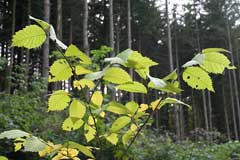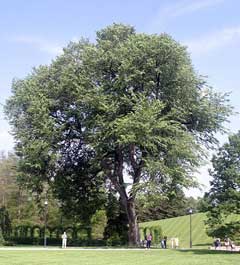 |
|
commons.wikimedia.org/wiki/User:Jean-Pol_GRANDMONT |
 |
| en.wikipedia.org/wiki/User:Henryhartley |
Translate this page:
Summary
Bloom Color: Green. Main Bloom Time: Early spring, Late spring, Mid spring. Form: Vase.
Physical Characteristics

 Ulmus americana is a deciduous Tree growing to 25 m (82ft) by 25 m (82ft) at a medium rate.
Ulmus americana is a deciduous Tree growing to 25 m (82ft) by 25 m (82ft) at a medium rate.
See above for USDA hardiness. It is hardy to UK zone 3 and is not frost tender. It is in flower in May, and the seeds ripen in June. The species is hermaphrodite (has both male and female organs) and is pollinated by Wind.
Suitable for: light (sandy), medium (loamy) and heavy (clay) soils and prefers well-drained soil. Suitable pH: mildly acid, neutral and basic (mildly alkaline) soils. It can grow in semi-shade (light woodland) or no shade. It prefers moist soil.
UK Hardiness Map
US Hardiness Map
Synonyms
U. floridana.
Plant Habitats
Woodland Garden Canopy;
Edible Uses
Edible Parts: Leaves
Edible Uses: Coffee
Leaves - raw or cooked. The red inner bark has been used to make a coffee-like drink[257].
References More on Edible Uses
Medicinal Uses
Plants For A Future can not take any responsibility for any adverse effects from the use of plants. Always seek advice from a professional before using a plant medicinally.
Antispasmodic Astringent Birthing aid Dysentery Haemostatic Salve
An infusion made from the bark has been used in the treatment of bleeding from the lungs, ruptures, coughs, colds, influenza, dysentery, eye infections, cramps and diarrhoea[226, 257]. An infusion of the bark has been taken by pregnant women to secure stability of children[257]. A decoction of the bark has been used as a wash on wounds[257]. A decoction of the inner bark has been taken in the treatment of severe coughs, colds, menstrual cramps[257]. An infusion of the inner bark has been drunk, and used as a bath, in the treatment of appendicitis[257]. An infusion of the root bark has been used in the treatment of coughs, colds and excessive menstruation[257]. A decoction has been used as an eye wash in the treatment of sore eyes[257]. The inner bark has been used as an emollient on tumours[257].
References More on Medicinal Uses
The Bookshop: Edible Plant Books
Our Latest books on Perennial Plants For Food Forests and Permaculture Gardens in paperback or digital formats.

Edible Tropical Plants
Food Forest Plants for Hotter Conditions: 250+ Plants For Tropical Food Forests & Permaculture Gardens.
More

Edible Temperate Plants
Plants for Your Food Forest: 500 Plants for Temperate Food Forests & Permaculture Gardens.
More

More Books
PFAF have eight books available in paperback and digital formats. Browse the shop for more information.
Shop Now
Other Uses
Containers Paper String Wood
A fibre obtained from the stems is used in making paper[189]. The stems are harvested in spring, the leaves are removed and the stems steamed until the fibres can be stripped. The outer bark is removed from the inner bark by scraping or peeling. The fibres are cooked for 2 hours with lye and then beaten with mallets. The paper is beige in colour[189]. The inner bark is very fibrous and is used in making string and strong ropes[149, 226]. The bark has been used to make various containers, including those used for gathering maple syrup[226]. Wood - hard, strong, heavy, durable, coarse grained, shrinks moderately though it tends to warp and twist, it bends well and is difficult to split. The wood is very durable in water. It weighs 40lb per cubic foot and is harvested commercially for flooring, wheel hubs, cooperage, agricultural implements and many other uses[46, 61, 82, 149, 171, 226, 227].
Special Uses
References More on Other Uses
Cultivation details
Landscape Uses:Firewood, Aggressive surface roots possible, Specimen, Street tree. Prefers a fertile soil in full sun[188], but it can be grown in any soil of at least moderate quality so long as it is well drained[1]. Trees are moderately fast-growing and live for at least 300 years in the wild[227, 229], but they do not thrive in Britain[1]. This species is particularly susceptible to 'Dutch elm disease'[274], a disease that has destroyed the greater part of all the elm trees growing in Britain. The disease is spread by means of beetles. Mature trees killed back by the disease will often regrow from suckers, but these too will succumb when they get larger. There is no effective cure (1992) for the problem, but most E. Asian, though not Himalayan, species are resistant (though not immune) to the disease so the potential exists to use these resistant species to develop new resistant hybrids with the native species[200]. The various species of this genus hybridize freely with each other and pollen is easily saved, so even those species with different flowering times can be hybridized[200]. Special Features:North American native, Inconspicuous flowers or blooms.
References Carbon Farming Information and Carbon Sequestration Information
Temperature Converter
Type a value in the Celsius field to convert the value to Fahrenheit:
Fahrenheit:
The PFAF Bookshop
Plants For A Future have a number of books available in paperback and digital form. Book titles include Edible Plants, Edible Perennials, Edible Trees,Edible Shrubs, Woodland Gardening, and Temperate Food Forest Plants. Our new book is Food Forest Plants For Hotter Conditions (Tropical and Sub-Tropical).
Shop Now
Plant Propagation
Seed - if sown in a cold frame as soon as it is ripe, it usually germinates within a few days[200]. Stored seed does not germinate so well and should be sown in early spring[200]. The seed can also be harvested 'green' (when it has fully developed but before it dries on the tree) and sown immediately in a cold frame. It should germinate very quickly and will produce a larger plant by the end of the growing season[80]. When they are large enough to handle, prick the seedlings out into individual pots and grow them on in the greenhouse for their first winter. Plant them out into their permanent positions in late spring or early summer, after the last expected frosts. Plants should not be allowed to grow for more than two years in a nursery bed since they form a tap root and will then move badly. Layering of suckers or coppiced shoots[200].
Other Names
If available other names are mentioned here
Native Range
NORTHERN AMERICA: Canada (Québec, Ontario, Prince Edward Island, New Brunswick, Saskatchewan, Manitoba), United States (Indiana, Maine, Massachusetts, Michigan, New Hampshire, New Jersey, New York, Ohio, Pennsylvania, Rhode Island, Vermont, West Virginia, Connecticut, Iowa, Kansas, Minnesota, Missouri, Nebraska, North Dakota, South Dakota, Illinois, Oklahoma, Wisconsin, Montana, Wyoming, Alabama, Arkansas, Delaware, District of Columbia, Florida, Kentucky, Louisiana, Maryland, North Carolina, South Carolina, Virginia, Mississippi, Tennessee, Texas)
Weed Potential
Right plant wrong place. We are currently updating this section.
Please note that a plant may be invasive in one area but may not in your area so it's worth checking.
Conservation Status
IUCN Red List of Threatened Plants Status :

Growth: S = slow M = medium F = fast. Soil: L = light (sandy) M = medium H = heavy (clay). pH: A = acid N = neutral B = basic (alkaline). Shade: F = full shade S = semi-shade N = no shade. Moisture: D = dry M = Moist We = wet Wa = water.
Now available:
Food Forest Plants for Mediterranean Conditions
350+ Perennial Plants For Mediterranean and Drier Food Forests and Permaculture Gardens.
[Paperback and eBook]
This is the third in Plants For A Future's series of plant guides for food forests tailored to
specific climate zones. Following volumes on temperate and tropical ecosystems, this book focuses
on species suited to Mediterranean conditions—regions with hot, dry summers and cool, wet winters,
often facing the added challenge of climate change.
Read More
Expert comment
Author
L.
Botanical References
1143200
Links / References
For a list of references used on this page please go here
Readers comment
© 2010, Plants For A Future. Plants For A Future is a charitable company limited by guarantee, registered in England and Wales. Charity No. 1057719, Company No. 3204567.